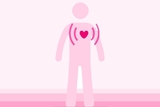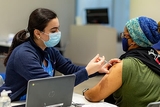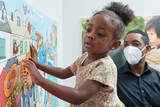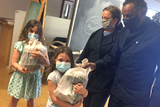2021 Community Impact Report
Our work outside the hospital walls to improve children's health
Caring for children when they are in the hospital or at a doctor’s appointment is only the beginning. Our mission is to improve every child’s health and well-being, which means caring for children where they are: in the community. Here are some steps we’re taking to meet that goal.

Helping Families Overcome Trauma & Grow Resilience
Children living in the neighborhoods around the Children’s Hospital of Philadelphia campus in West and Southwest Philadelphia have experienced more than their fair share of trauma, which only increased with the COVID-19 pandemic and the rise in gun violence.

Trusted Source of Vaccine Information
The pandemic only elevated the value and reach of CHOP’s Vaccine Education Center.

Rec Centers Prepared for Cardiac Arrest
Every Philadelphia recreation center now has an automated external defibrillator and trained staff because of Youth Heart Watch.

Vaccinating Teachers to Help Kids
CHOP vaccinated 19,000 school personnel so Philadelphia kids could get back into classrooms and daycares.
“From warding off the long-term effects of trauma with neighborhood-based counseling to vaccinating 19,000 school personnel against COVID-19 so kids could get back in the classroom, our programs in the community, with the community, strive to improve the health of children right where they live.”

Picture This!
Vibrant, interactive murals in CHOP primary care exam rooms spark interaction and help clinicians assess kids.

Serving Food — and Love
CHOP supported a free family dinner program in Chester County to support food-insecure families and a local culinary school.
Our Financial Commitment to the Community
When all of the programs and services that Children’s Hospital of Philadelphia provides to the communities we serve are combined, the cost is more than $470 million in fiscal year 2021.
Financial Assistance / Charity Care
Cost of medical care services for families that qualify for CHOP’s financial assistance policy
Amount: $6,947,711
Medicaid Programs
Unreimbursed cost of Medicaid and other means-tested government health programs
Amount: $210,872,499
Community Health Improvement Services
Community-based clinical services, health education and support services focused on public health
Amount: $10,147,067
Health Professions Education
Net costs incurred by CHOP to train health professionals, including pediatricians
Amount: $50,042,780
Subsidized Health Services
Hospital-based clinical services provided at a financial loss to the organization
Amount: $47,779,262
Research
Cost of studies that identify new treatments and cures
Amount: $144,197,754
Cash and In-kind Contributions
Funds and goods provided to other organizations to provide community benefit
Amount: $326,696
All financial data is for fiscal year July 1, 2020, through June 30, 2021. These reports include amounts expended by Children’s Hospital of Philadelphia’s hospital facilities, as reported on Schedule H of the IRS Form 990, and our controlled affiliates, including our physician practice plans, which are not required to complete Schedule H. Accordingly, the values on this fact sheet are greater than the amounts reported in the CHOP Schedule H, which applies only to our hospital facilities. It does not include grants and contributions that support community benefit programs. For more information, call CHOP’s Office of Community Impact at 267-426-5506.
Financial Assistance Policy Summary: The mission of Children’s Hospital of Philadelphia (CHOP) is to advance healthcare for children. To help children get the care that they need, CHOP provides financial assistance for medically necessary and emergency care to patients who meet the eligibility requirements. If CHOP determines that a patient is eligible, CHOP will waive 100% of the patient’s financial responsibility (after all applicable insurances and other government assistance). Learn more here.